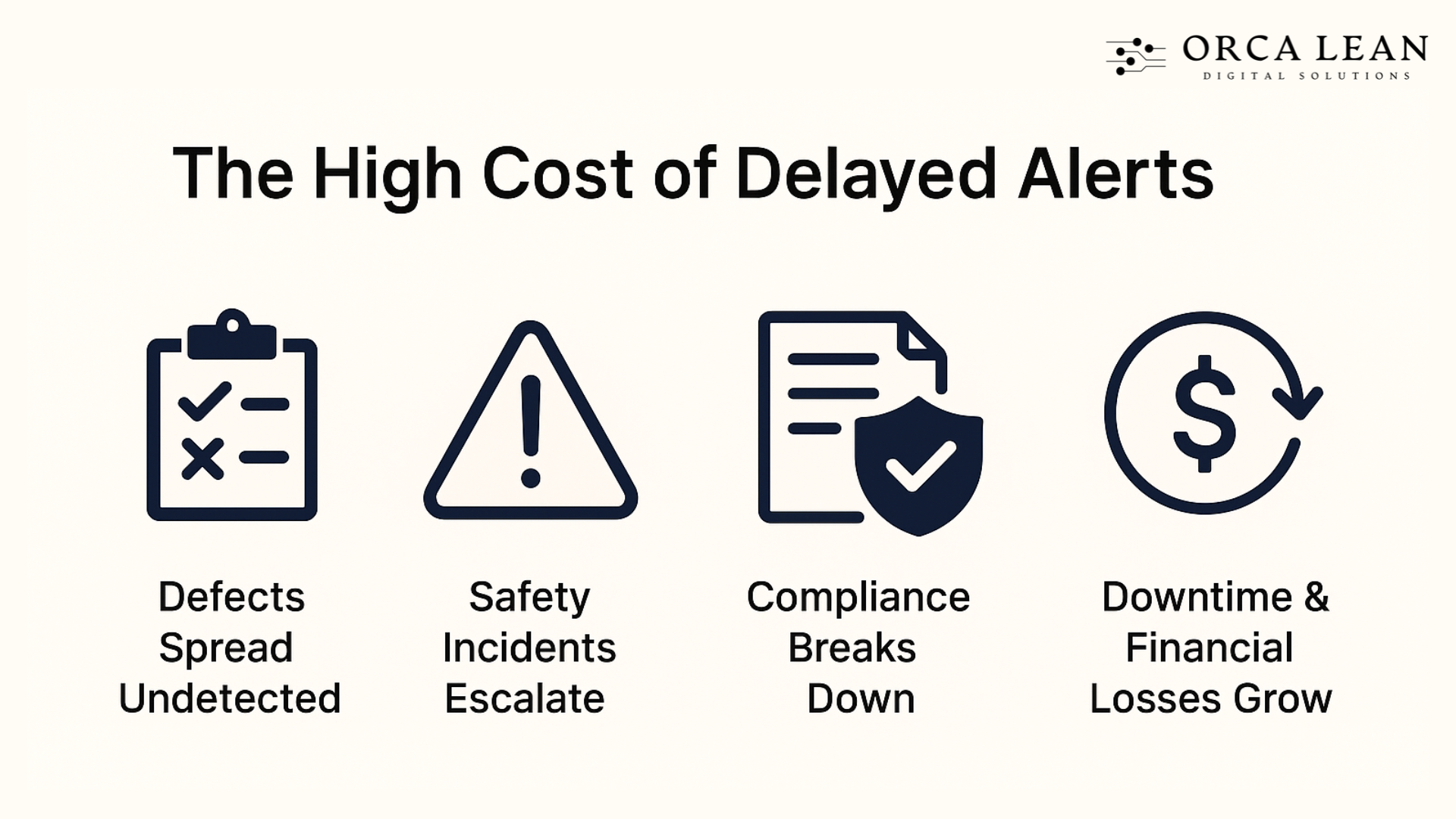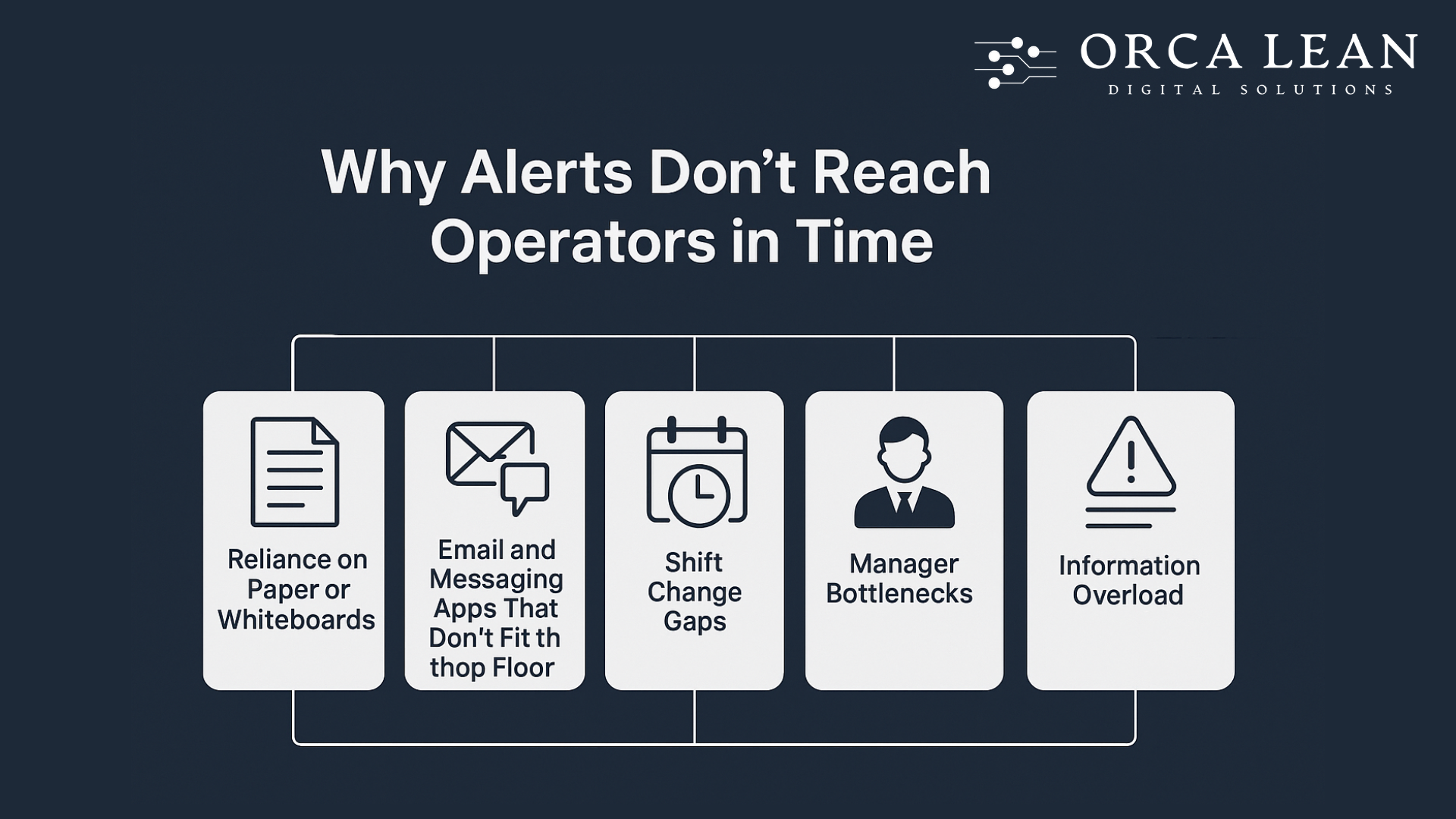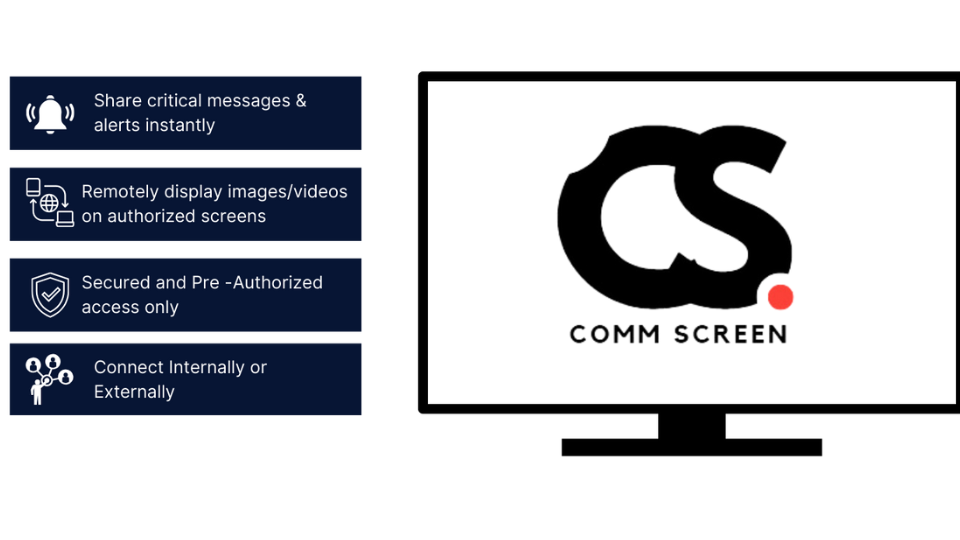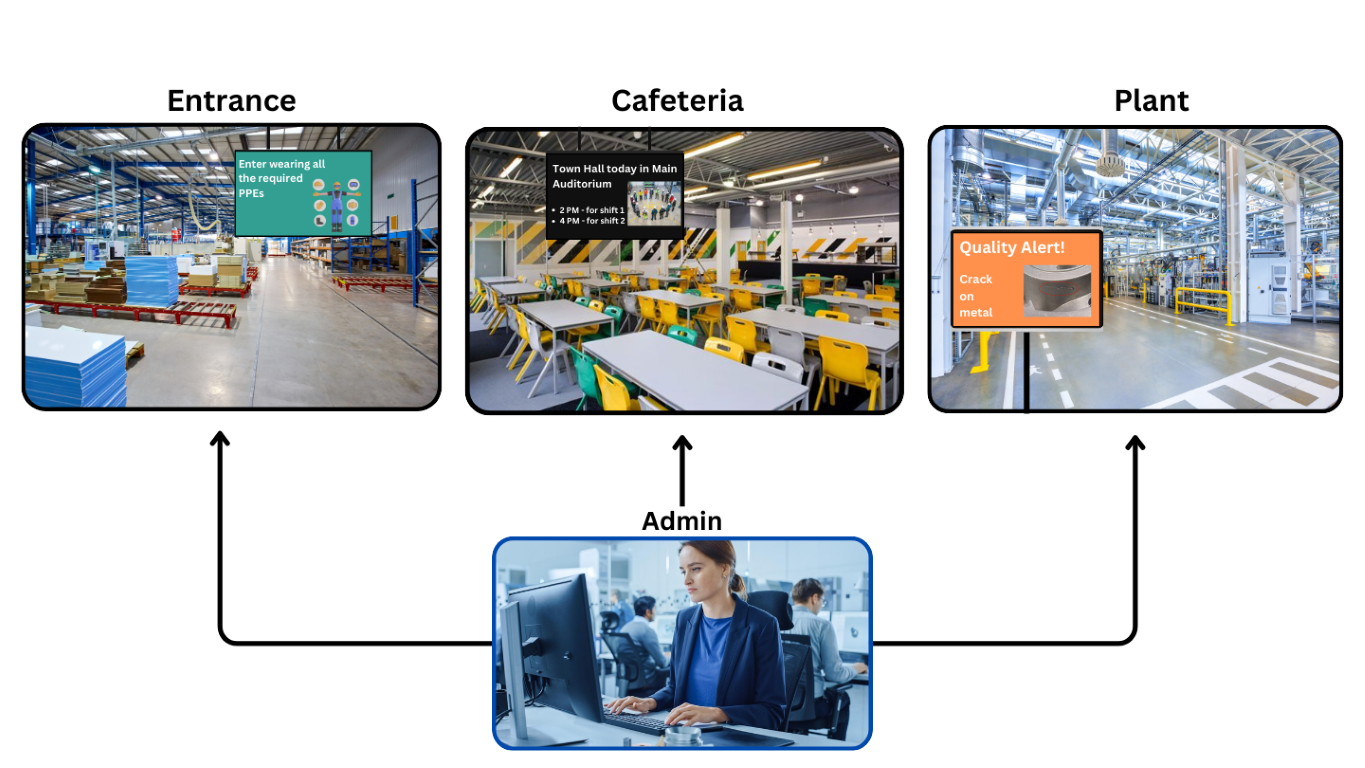Why Safety and Quality Alerts Don’t Reach the Shop Floor in Time
September 29, 2025
In modern manufacturing, machines move faster, lines are automated, and customer expectations are higher than ever. Yet, one of the simplest and most important processes—getting safety and quality alerts to operators—remains broken in many factories. Critical messages often arrive late, leaving workers to operate with outdated instructions or, worse, exposing them to risks they could have avoided. The result? Defects multiply, accidents go unprevented, and compliance violations stack up.
The question is simple: why do alerts take so long to reach the shop floor, and how can manufacturers close this dangerous gap?
The High Cost of Delayed Alerts
A late alert is more than just a communication hiccup—it’s a manufacturing risk multiplier.

- Defects spread undetected. A batch of parts with a discovered flaw may continue down the line for hours because operators never got the updated inspection criteria in time. By the time the issue surfaces, dozens—or even hundreds—of units need rework or scrapping.
- Safety incidents escalate. Imagine a leaking chemical valve or a misaligned press. If workers aren’t warned immediately, the chances of accidents or near-misses rise exponentially.
- Compliance breaks down. Regulatory bodies expect proof that safety and quality procedures are followed. If alerts don’t reach operators instantly, audits uncover gaps, fines are issued, and certifications like ISO, IATF, or FDA approvals are at risk.
- Downtime and financial losses grow. Every minute operators work with the wrong instructions translates into wasted labor, lost material, and production delays.
In some U.S. manufacturing plants, the cost of one delayed quality alert in factory can run into tens of thousands of dollars. Safety-related incidents are even more expensive, involving injury claims, legal costs, and reputational damage.
Why Do Alerts Don’t Reach Operators in Time?
Even in highly automated factories, communication is still one of the weakest links. Safety and quality alerts often fail to reach operators in time—not because managers don’t care, but because the systems in place are outdated, fragmented, or too slow for the pace of production. Let’s break down the common causes, with real-world examples from shop floor environments.

1. Reliance on Paper or Whiteboards
In many plants, critical updates are written on a whiteboard near the supervisor’s office or taped to bulletin boards.
- Example: A food processing plant updates allergen-cleaning procedures on a paper notice at 6 AM. The first shift sees it, but the second shift doesn’t notice the paper change tucked into the corner of a crowded board. By the time they realize the cleaning procedure has changed, an entire batch must be discarded.
Paper-based communication simply cannot keep up with high-volume production schedules.
2. Email and Messaging Apps That Don’t Fit the Shop Floor
While engineers and managers check their inboxes regularly, operators rarely have access to email during shifts. Even messaging apps like WhatsApp or Teams don’t translate well on a noisy factory floor.
- Example: In an automotive assembly line, a torque specification update is sent out via email to supervisors at 9:00 AM. Operators tightening bolts never see the email, and dozens of vehicles are assembled with incorrect torque settings before the mistake is caught at quality inspection.
By the time the alert reaches workers, it’s already too late.
3. Shift Change Gaps
Factories run on multiple shifts, and handovers are one of the biggest weak points for communication. If a supervisor forgets to pass along a critical alert—or does so informally—the message dies at the shift boundary.
- Example: In a chemical plant, a supervisor tells the night shift about a pressure valve issue but forgets to log it in writing. When the morning shift comes in, they assume everything is normal. Hours later, the same issue resurfaces, forcing an emergency shutdown.
Verbal communication alone is unreliable when safety is at stake.
4. Manager Bottlenecks
Often, alerts are routed through supervisors or plant managers for approval before they reach the floor. This slows down response time.
- Example: In an electronics assembly plant, an inspection engineer notices a soldering defect that could affect thousands of circuit boards. Instead of alerting operators immediately, the issue must be “validated” by two levels of management. By the time approval is given, the defect has already spread across three production lines.
Speed suffers when information flows through layers instead of directly to workers.
5. Information Overload
Even when alerts are sent, they’re often buried under less urgent messages. Workers tune out because they can’t distinguish between “critical” and “nice-to-know.”
- Example: A packaging plant sends updates on daily targets, HR reminders, and cafeteria menu changes on the same channel used for safety alerts. When an urgent message about a faulty sealing machine comes through, operators ignore it—thinking it’s another routine announcement.
In manufacturing, not all messages are equal. But without a clear system, everything blends together, and critical alerts lose visibility.
The Pattern
In each of these scenarios, the problem isn’t a lack of communication effort—it’s a lack of the right medium for fast, clear, and reliable alerts. Operators are left relying on outdated tools, fragmented channels, or incomplete messages. Meanwhile, machines keep running, products keep moving, and risks escalate before anyone reacts.
The Shop Floor Reality: Information Moves Slower Than Machines
On the production line, machines run in seconds, conveyors move non-stop, and defects can multiply in minutes. But communication systems in many factories move at the speed of paper, email, and word of mouth.
This mismatch creates a dangerous lag: by the time operators know there’s a safety or quality issue, the damage is already done. Factories that invest millions in automation often overlook the fact that their human communication layer is slower than their machines.
What’s Needed: A Real-Time, Visual Communication Layer
The solution isn’t more emails or longer memos. What manufacturers need is:
- Instant communication: alerts must reach the shop floor in seconds, not hours.
- Visual clarity: messages should be displayed in a way that’s impossible to miss.
- Shift-proof updates: no matter who’s on duty, everyone should see the same critical message at the same time.
- Simplicity: operators shouldn’t need to log in or dig through apps to find the update.
In short, factories need a visual management system built for the speed of modern manufacturing.
Want to know how real-time alerts and messages help factory operators while not making any delays and mistakes? Check out our video.
Introducing Comm Screen: Real-Time Alerts Without the Delay
This is where Comm Screen comes in—the digital tool designed to close the gap between management and the shop floor.
With Comm Screen, managers can instantly broadcast alerts across multiple smart TVs and monitors on the factory floor from a single location. Whether it’s a safety warning, a quality stop, or an urgent change in process, every operator sees it in real-time—clearly and visually.

- Centralized control: one person can push alerts plant-wide in seconds.
No reliance on paper, email, or word-of-mouth. - Visual, unmissable updates that align perfectly with lean’s “make it visible” principle.
- Seamless shift coverage: operators walking in mid-shift immediately see the same alerts as everyone else.
It’s not about replacing managers. It’s about giving them a tool that ensures their critical instructions actually reach the people who need them—without delay.
How Comm Screen Solves Safety & Quality Alert Delays
- For Safety Alerts: push emergency evacuation instructions or hazard notices instantly across the plant. Workers don’t have to rely on radios or slow supervisors.
- For Quality Alerts: stop bad parts from spreading by immediately alerting operators to check, stop, or reconfigure.
- For Compliance: prove during audits that alerts were not just sent, but displayed visually across the shop floor.
By bridging the communication gap, Comm Screen turns “we told them too late” into “everyone knew instantly.”
Conclusion: From Delayed Alerts to Instant Action
Delayed alerts are a silent killer of manufacturing efficiency, safety, and compliance. The risks are too costly to ignore, yet many plants still rely on outdated methods like paper notes, emails, or word-of-mouth.
The good news: communication doesn’t have to be this slow anymore. With Comm Screen, U.S. manufacturers can put an end to delayed alerts and give operators the clarity they need—when they need it.
If your plant is still struggling with late safety and quality communication, it’s time to make the switch. Explore Comm Screen today and make real-time alerts your factory’s new standard.

Software Solutions for Manufacturing Excellence
Company
Social
Our Contact Info:
Email: contact@orcalean.com
Phone Number: 248 938 0375
Our Offices

